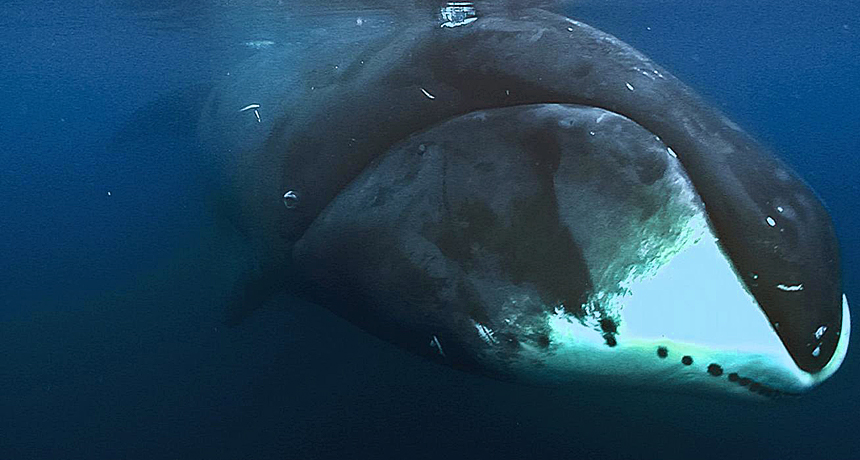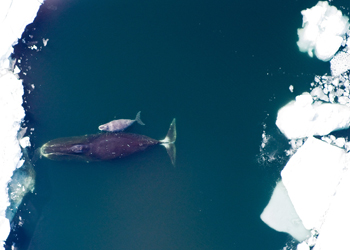A whale of a lifespan
Bowhead whales may unlock the secrets to a long, healthy life

The bowhead whale is the first large whale to have its genome analyzed. Researchers are using its genetic blueprint to probe how it is that this species can live longer than 200 years.
LOKE FILM AND ADAM SCHMEDES/CELL REPORTS 2015
Bowhead whales can live 200 years or longer. How they do it is no longer among the secrets of the deep.
Scientists have mapped the genetic code of this long-lived whale species. The international effort found unusual features in the Arctic whale’s genes. Those features likely protect the species against cancer and other problems related to old age. The researchers hope their findings will one day translate into ways to help people too.
“We hope to learn what is the secret for living longer, healthier lives,” says João Pedro de Magalhães. He is a gerontologist at the University of Liverpool in England. (Gerontology is the scientific study of old age.) He also is co-author of the study that appeared January 6 in Cell Reports. His team hopes, he says, that its new findings might one day be used “to improve human health and preserve human life.”
No other mammal is known to live as long as the bowhead (Balaena mysticetus). Scientists have shown that some of these whales have lived well beyond 100 — including one that survived to 211. For perspective, if he were still alive, Abraham Lincoln would be turning just 206 this year.
De Magalhães’ team wanted to understand how the bowhead can live so long. To probe this, the experts analyzed the animal’s complete set of genetic instructions, called its genome. Those instructions are coded in the animal’s DNA. The team also compared the whale’s genome to those of people, mice and cows.

The scientists discovered differences, including mutations, in the whale’s genes. Those changes are linked to cancer, aging and cell growth. The results suggest that the whales are better than humans at repairing their DNA. That’s important because damaged or flawed DNA can lead to diseases, including some cancers.
Bowheads also are better at keeping abnormally dividing cells in check. Together, the changes appear to allow bowhead whales to live longer without developing age-related diseases such as cancer, says de Magalhães.
Power Words
baleen A long plate made of keratin (the same material as your fingernails or hair). Baleen whales have many plates of baleen in their mouths instead of teeth. To feed, a baleen whale swims with its mouth open, collecting plankton-filled water. Then it pushes water out with its enormous tongue. Plankton in the water become trapped in the baleen, and the whale then swallows the tiny floating animals.
bowhead A type of baleen whale that lives in the high Arctic. Roughly 4 meters (13 feet) long and 900 kilograms (2,000 pounds) at birth, it grows to an enormous size and may live well over a century. Adults can span 14 meters (40 feet) and weigh up to 100 metric tons. They use their massive skulls to break through ice to breathe. Lacking teeth, they sieve the water, straining out tiny plankton and fish to sustain their huge size.
cancer Any of more than 100 different diseases, each characterized by the rapid, uncontrolled growth of abnormal cells. The development and growth of cancers, also known as malignancies, can lead to tumors, pain and death.
cell The smallest structural and functional unit of an organism. Typically too small to see with the naked eye,it consists of watery fluid surrounded by a membrane or wall. Animals are made of anywhere from thousands to trillions of cells, depending on their size.
cetaceans The order of marine mammals that includes whales, dolphins and porpoises. The baleen whales (Mysticetes) filter their food from the water with big baleen plates. The remaining cetaceans (Odontoceti) include some 70 species of toothed animals that include beluga whales, narwhals, killer whales (a type of dolphin) and porpoises.
DNA (short for deoxyribonucleic acid) A long, spiral-shaped molecule inside most living cells that carries genetic instructions. In all living things, from plants and animals to microbes, these instructions tell cells which molecules to make.
gene A segment of DNA that codes, or holds instructions, for producing a protein. Offspring inherit genes from their parents. Genes influence how an organism looks and behaves.
genome The complete set of genes or genetic material in a cell or an organism.
gerontologyThe scientific study of old age, including the problems and processes associated with aging. An expert in gerontology is a gerontologist.
mammal A warm-blooded animal distinguished by the possession of hair or fur, the secretion of milk by females for feeding the young, and (typically) the bearing of live young.
mutation Some change that occurs to a gene in an organism’s DNA. Some mutations occur naturally. Others can be triggered by outside factors, such as pollution, radiation, medicines or something in the diet. A gene with this change is referred to as a mutant.
species A group of similar organisms capable of producing offspring that can survive and reproduce.







